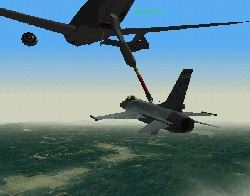| Air to Air Refueling in Falcon 4
by Major Mark "Slarti" Collins, 187th VFW Avengers |
||||
|
Forward As with all things, it is easier to learn something if you approach it by first breaking it down into its most elemental pieces and then examining each of those pieces. This is how we will approach the "Bane of all Falcon Pilots", i.e. Air to Air refueling. The following items are the critical components necessary for making an approach and hookup with a tanker for A2A refueling: Altitude (pitch), Attitude (roll), and Speed (power). Basically, you have to line up horizontally, line up vertically, and match speeds with the tanker in order for them to be able to hookup an give you some gas. Sounds pretty easy, doesn’t it. So let's look at these pieces and get some clues on what we're doing wrong and what we need to do to be able to hookup with the tanker. Bobbin' and Weavin' While Bobbin and Weavin is great for a prize fighter, it is the last thing that you want when tryin to hookup to the tanker. It is probably the one thing that most of us struggle with that make it impossible to hookup to the tanker. For the purposes of this discussion I will define Bobbing as Pitch, and Weaving as roll. Why we bobbin? We are flying the boom, i.e. we are trying to line up with the boom. This is a mistake since the boom will be flown to us. All we have to do is get in the general vicinity of the boom and the boom operator will fly the boom to us. We are NOT flyin the Flight Path Marker. If we are to hookup with tanker we must fly straight and level. The most important thing that I have found to stop diving and climbing, aka "bobbin" is to make sure that I’m flyin the Flight Path Marker. Keep that baby lined up with the Horizon Line on the HUD and presto….no more bobbin. You want to line up with the tanker right from the start so you don’t have to make huge pitch corrections. Just fly straight and level. Now your major concern should be roll correction.
 Why we weavin? Weavin is gonna happen because you need to line up with the tanker. The key to victory here is very small corrections and USE THE RUDDER PEDALS! I have found that using the rudder pedal with the stick, i.e. very small, co-coordinated turns is what gets me through it. (if you don’t have rudders, don’t fret. You can still make it w/o rudders…just makes it a little easier.) Again, the key here is very small corrections. Remember, the plane doesn’t fly like a car, it’s more like sliding across ice. You have to anticipate and correct before the correction is needed. |
 Rules of Thumb 1. Fly the Tanker. Don’t try to fly the boom. Since the entry point for the fuel is behind your head, you won’t see where to direct the boom anyway. The guys that work the boom are union, so they would be really PO’ed if you took their jobs away from them. So, fly the tanker. Work at positioning yourself under the tanker. 2. Fly the Horizon. Fly the tanker to get in close, but once you're close in you will need to start flying the horizon. It's just like driving a car. You can’t watch the road down by your wheel and drive effectively. You need to drive the car by watching way ahead of you. The same applies to getting underneath the tanker; you need to fly the horizon. That’s where you eyes should be looking and you should only briefly glance at the tanker. 3. Watch your speed. Now were stabilized. We’re basically flying at the same height, parallel with the horizon, and we’re basically lined up with the tanker. What now? Speed! How fast are you going? Here there are a couple of tricks that will help. Make sure that you use the Digital Air Speed Indicator (hit "ctrl H" to switch to this view) instead of the Analog Air Speed Indicator. It’s very hard to judge how fast you're going with just the tape. Make sure you are watching your Fuel Flow indicator. It helps to know how fast you should be going. I have found that when I’m in close, I want the consumption to be at about 2100 to 2300. That will give me a walking gait takeover speed, which is about what you want. Any slower and you won’t catch the tanker. (Obviously you want your initial approach speed with the tanker with a greater than this but when you get close, i.e. you can see the boom, then you need to start to really manage your speed. It is better to slow gradually then to slam on the air brakes and try and match speed that way.) The manual says that the tanker is traveling at approximately 300 kts, personally I have found that when I'm in close I need to slow to about 297-300 kts. At this speed, I can overtake the tanker. According to the manual, your approach should be somewhere between, 300 and 305 kts. Experiment with this. I have found that 302 is too fast, I fly past the tanker. It seems that hookup speed for me is 297 kts. Go to Part II
|
|||
|
Copyright © 1997 - 2000 COMBATSIM.COM, INC. All Rights Reserved. Last Updated August 30th, 1999 |
||||
